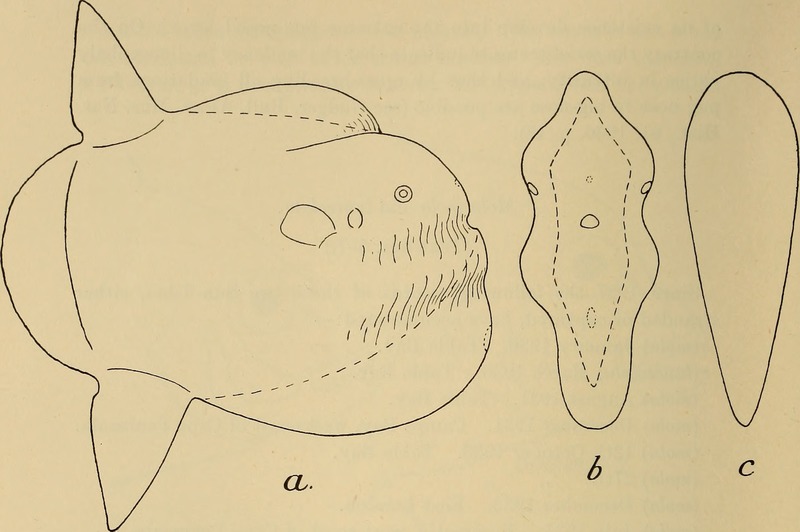Masturus lanceolatus (sharptail mola) Fig.4. -- a, Outline of the Kommetje 1934 Sun-fish; the broken line represents the outline of a normal specimen. b, Cross-section of same, the broken line being the normal cross-section in Mola mola. c, Cross-section of Mola lanceolata ( = Masturus lanceolatus )
Title: Annals of the South African Museum = Annale van die Suid-Afrikaanse Museum
Year: 1898
Book Page: https://archive.org/details/annalsofsouthafr30193sout/page/654/mode/1up?view=theater
Source: https://commons.wikimedia.org/wiki/File%3AAnnals_of_the_South_African_Museum_-_Annale_van_die_Suid-Afrikaanse_Museum_%281931%29_%2818396587366%29.jpg
The sharptail mola (Masturus lanceolatus) is a species of mola famaily Molidae found in tropical and temperate waters around the world. It is one of the largest bony fishes, measuring up to 3.4 m long and weighing up to 2 tons. The sharptail mola has an oval body with an evenly convex forehead profile. The eyes are placed more forward on the head than in the genus Mola. The teeth in both jaws are fused into beak-like plates. The dorsal and anal fins are placed posteriorly, and the base of the dorsal fin is longer than that of the anal fin. In place of a caudal fin, the dorsal and anal fins merge into a clavus, formed by 18-20 fin rays. The central rays in the clavus are supported by the last vertebra and form an elongated triangular lobe; some authors believe these rays to be remnants of the larval caudal fin, though this is disputed. Their skin is covered with small dermal denticles that are finer than those of the ocean sunfish. Their coloration is silvery with the upper parts of the sides grayish brown to blackish. The sides may bear ill-defined dark spots. The dorsal and anal fins are slate gray, while the clavus may have pale blotches.
Order: Tetraodontiformes
Family: Molidae
Genus: Masturus
Species: Masturus lanceolatus (É. Liénard, 1840)
Synonyms:
- Orthagoriscus lanceolatus Liénard, 1840
- Pseudomola lassarati Cadenat, 1959
